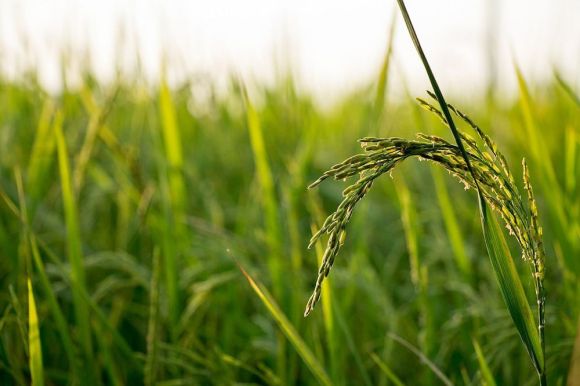TOKYO — Japan’s high-tech agricultural businesses are to gather at the Agri World trade fair held in Tokyo this week (Oct 12-14) to showcase the industries next generation of technologies such as plant factories, robotic automation and IT systems, claimed as advancing the “fourth industrial revolution” into the sector.

Business analysts forecast the “agri-tech” market is primed for extensive growth internationally over the decades ahead. As global population is expected to reach 9 billion by 2050, food needs would require a doubling of agricultural production, state U.N. World Food Programme experts.
Offering technological solutions, “agri-tech” businesses are marketing a wide variety of products and services for meeting industry demands, to generally increase productivity, lower costs, use less resources such as energy, water and pesticides, and improve produce quality and availability.
There is also a strong demand for labor saving and assistive agricultural equipment driven by a different demographic trend, that of ageing agricultural farmers, whereby according to U.N. figures, in developed countries the average age is 60, and where in Japan it has risen to 67.
Overall Japan has a shrinking agricultural sector, demonstrated by government data showing the number of full-time farmers at 1.7 million in 2014, declining from 2.2 million a decade earlier. Workforce and skills shortages are compounded by the lack of young people becoming farmers. Also, due to the increasing rate of farmers retiring, the overall amount of uncultivated farmland within Japan has doubled over the past two decades, increasing to 420,000 hectares in 2015.
Japan’s reliance on food imports is a further factor of concern, currently estimated at 60%, prompting recent government targets for boosting domestic production to 55% by 2050. Agricultural production at present is valued at around 1 trillion yen of which the government aims to increase to 10 trillion yen by 2020, raising food self-sufficiency as a major agricultural policy.
Another government initiative is 4 billion yen budgeted over the year through March for promoting farming automation technology in order to raise crop yields and make-up for workforce deficits. Specifically, the financial subsidy supports the development of 20 robot types, such as devices which separate over-ripe fruits during harvesting, to enable large reductions in manual farm labor.
As physical activities bring more difficulties for a greater number of aging farmers, technological innovations to assist with and replace workers performing agricultural tasks is an urgent priority.
Japanese tech companies are heavily investing in agricultural technology as a big opportunity for profits in both domestic and global markets such as India and the APAC countries, attracting small scale start-ups to big corporations such as Mitsubishi, Fujitsu, and Panasonic, to name but a few.
There is also a trend for farmland in Japan to be cultivated by “business farmers” and “agribusiness,” at around 50% today, leading to 80% by 2025, according to government estimates.
As an indicator of growth potential in the “agri-tech” sector, the global market for agricultural robots is projected to reach $73.9 billion by 2024, up from $3 billion in 2015, predicted by Tractica, a market intelligence firm. Driverless tractors are trended to gain the highest revenue at $30.7 billion by 2024, with agricultural drones comprising the most amount of units shipped.
The applications of farming technologies are wide ranging and often interconnect. A typical farm scenario could involve a driverless tractor in a rice paddy field utilising a global positioning system, both synchronised to automate cultivation and fertilization after monitoring the soil conditions.
For work that is harder to be automated, wearable robotics put on like a backpack have been designed to assist harvesting and carrying produce, more so for elderly and female farmers.
As well as automating work, high-tech farming technologies provide accurate information which farmers can use to make decisions managing crops. For example, a combination of high resolution drone images, historical weather data from geo-satellites and sensors in the field would generate real-time alerts on mobile devices to inform farmers when to reduce a mandarin orchards water supply, so the trees absorb less water from the soil, therefore increasing sugar levels of the fruits.
The valuable experience and techniques of veteran farmers could also be more accessible to newer farmers via the web, such as learning resources about harvesting times with databases and photos.
Many news items about “agri-tech” businesses have featured in both the Japanese and international media, with reports of indoor “vertical farms” and automated greenhouses gaining the most coverage. There is often a focus on robotic automation, also the use of IT systems and sensors to measure and control growing processes, evidently enhancing work efficiencies, crop yields and produce quality.
For example, GRA Inc is a medium-size Japanese business with an automated indoor greenhouse facility producing strawberries, providing a reliable quality and increased supply all year round.
The company joins conventional farming expertise and technological innovation, employing local farmers as advisors and management, founded by a former IT administrator turned agriculturalist.
Based in Miyagi Prefecture, the business started a few months after the Tōhoku disaster. In an area famous for its strawberries, thousands of greenhouses were destroyed and damaged ensuing huge losses for farmers. The business has therefore helped to modernise and revitalise regional trade.
Such stories show the real potential for young tech-savvy farmers to work alongside older, more experienced farmers, toward overcoming the challenges confronting Japan’s agricultural industry.
Allan Croft is a freelance writer focusing on the latest science, tech and green news in Japan and Asia.

 Welcome the New Year with a calendar of hunky Japanese farmers 【Pics】
Welcome the New Year with a calendar of hunky Japanese farmers 【Pics】 Food by Fujitsu: Rise of the super veggie!
Food by Fujitsu: Rise of the super veggie! Don’t let the cold seasons snuff out your style! Japan’s lady farmers get fresh new fashion line
Don’t let the cold seasons snuff out your style! Japan’s lady farmers get fresh new fashion line Shizuoka Prefecture may lose title of Japan’s top tea producer to rising star Kagoshima
Shizuoka Prefecture may lose title of Japan’s top tea producer to rising star Kagoshima Meet the “world’s best dressed farmer,” Japan’s Kiyoto Saito 【Video】
Meet the “world’s best dressed farmer,” Japan’s Kiyoto Saito 【Video】 Beautiful new Final Fantasy T-shirt collection on the way from Uniqlo【Photos】
Beautiful new Final Fantasy T-shirt collection on the way from Uniqlo【Photos】 Disney princesses get official manga makeovers for Manga Princess Cafe opening in Tokyo
Disney princesses get official manga makeovers for Manga Princess Cafe opening in Tokyo Foreign English teachers in Japan pick their favorite Japanese-language phrases【Survey】
Foreign English teachers in Japan pick their favorite Japanese-language phrases【Survey】 Randomly running into a great sushi lunch like this is one of the best things about eating in Tokyo
Randomly running into a great sushi lunch like this is one of the best things about eating in Tokyo Hey, Japanese taxi driver! Take us to your favorite restaurant in Tsuruga City!
Hey, Japanese taxi driver! Take us to your favorite restaurant in Tsuruga City! New Japanese mascot character: A train station monster that grabs children who don’t mind the gap
New Japanese mascot character: A train station monster that grabs children who don’t mind the gap Enjoy viewing Kyoto’s cherry blossoms from above on a guided zipline tour
Enjoy viewing Kyoto’s cherry blossoms from above on a guided zipline tour How to properly eat a traditional Japanese tonkatsu meal
How to properly eat a traditional Japanese tonkatsu meal Kyushu-exclusive Black Mont Blanc goes nationwide in a “Special” way
Kyushu-exclusive Black Mont Blanc goes nationwide in a “Special” way Sakura season schedule is screwed up, so we had a no-cherry blossom cherry blossom party in the office
Sakura season schedule is screwed up, so we had a no-cherry blossom cherry blossom party in the office We try out “Chan Ramen”, an underground type of ramen popular in the ramen community
We try out “Chan Ramen”, an underground type of ramen popular in the ramen community New Studio Ghibli bedding sets are cool in all senses of the word
New Studio Ghibli bedding sets are cool in all senses of the word Our Japanese reporter visits Costco in the U.S., finds super American and very Japanese things
Our Japanese reporter visits Costco in the U.S., finds super American and very Japanese things New Pokémon cakes let you eat your way through Pikachu and all the Eevee evolutions
New Pokémon cakes let you eat your way through Pikachu and all the Eevee evolutions There’s a park inside Japan where you can also see Japan inside the park
There’s a park inside Japan where you can also see Japan inside the park Japanese convenience store packs a whole bento into an onigiri rice ball
Japanese convenience store packs a whole bento into an onigiri rice ball Hanton rice — a delicious regional food even most Japanese people don’t know about, but more should
Hanton rice — a delicious regional food even most Japanese people don’t know about, but more should Final Fantasy, Kingdom Hearts, and Dragon Quest pet product line announced by Square Enix
Final Fantasy, Kingdom Hearts, and Dragon Quest pet product line announced by Square Enix Studio Ghibli releases Kiki’s Delivery Service chocolate cake pouches in Japan
Studio Ghibli releases Kiki’s Delivery Service chocolate cake pouches in Japan Japan’s bone-breaking and record-breaking roller coaster is permanently shutting down
Japan’s bone-breaking and record-breaking roller coaster is permanently shutting down New definition of “Japanese whiskey” goes into effect to prevent fakes from fooling overseas buyers
New definition of “Japanese whiskey” goes into effect to prevent fakes from fooling overseas buyers Foreign passenger shoves conductor on one of the last full runs for Japan’s Thunderbird train
Foreign passenger shoves conductor on one of the last full runs for Japan’s Thunderbird train Kyoto bans tourists from geisha alleys in Gion, with fines for those who don’t follow rules
Kyoto bans tourists from geisha alleys in Gion, with fines for those who don’t follow rules Studio Ghibli unveils Mother’s Day gift set that captures the love in My Neighbour Totoro
Studio Ghibli unveils Mother’s Day gift set that captures the love in My Neighbour Totoro Domino’s Japan now sells…pizza ears?
Domino’s Japan now sells…pizza ears? Toyota built a life-sized Miraidon Pokémon and are letting people test drive it this weekend
Toyota built a life-sized Miraidon Pokémon and are letting people test drive it this weekend New Japanese KitKat flavour stars Sanrio characters, including Hello Kitty
New Japanese KitKat flavour stars Sanrio characters, including Hello Kitty Sales of Japan’s most convenient train ticket/shopping payment cards suspended indefinitely
Sales of Japan’s most convenient train ticket/shopping payment cards suspended indefinitely Sold-out Studio Ghibli desktop humidifiers are back so Totoro can help you through the dry season
Sold-out Studio Ghibli desktop humidifiers are back so Totoro can help you through the dry season Japanese government to make first change to romanization spelling rules since the 1950s
Japanese government to make first change to romanization spelling rules since the 1950s Ghibli founders Toshio Suzuki and Hayao Miyazaki contribute to Japanese whisky Totoro label design
Ghibli founders Toshio Suzuki and Hayao Miyazaki contribute to Japanese whisky Totoro label design Doraemon found buried at sea as scene from 1993 anime becomes real life【Photos】
Doraemon found buried at sea as scene from 1993 anime becomes real life【Photos】 Tokyo’s most famous Starbucks is closed
Tokyo’s most famous Starbucks is closed One Piece characters’ nationalities revealed, but fans have mixed opinions
One Piece characters’ nationalities revealed, but fans have mixed opinions We asked a Uniqlo employee what four things we should buy and their suggestions didn’t disappoint
We asked a Uniqlo employee what four things we should buy and their suggestions didn’t disappoint Princesses, fruits, and blacksmiths: Study reveals the 30 most unusual family names in Japan
Princesses, fruits, and blacksmiths: Study reveals the 30 most unusual family names in Japan Studio Ghibli’s new desktop Howl’s Moving Castle will take your stationery on an adventure
Studio Ghibli’s new desktop Howl’s Moving Castle will take your stationery on an adventure 16 facts about China that will blow your mind
16 facts about China that will blow your mind Muji is selling sake, and it’ll make drinkers feel good in more ways than one
Muji is selling sake, and it’ll make drinkers feel good in more ways than one LED plant factories offer efficient 3D alternative to traditional gardening
LED plant factories offer efficient 3D alternative to traditional gardening 9 futuristic jobs we could see by 2030
9 futuristic jobs we could see by 2030 Here are the 10 richest companies in Japan: Can you guess which is number one?
Here are the 10 richest companies in Japan: Can you guess which is number one? Slimy green algae is taking over China’s beaches for an alarming reason
Slimy green algae is taking over China’s beaches for an alarming reason 16 facts about India that will blow your mind
16 facts about India that will blow your mind 【Exploring Unfamilar Japan】We have dessert and meet a cow named Julia at an organic island café
【Exploring Unfamilar Japan】We have dessert and meet a cow named Julia at an organic island café Japan’s first drone high school course to begin next year, teaches piloting, law, and more
Japan’s first drone high school course to begin next year, teaches piloting, law, and more Smartphone game’s virtual tour of Japan lets you win real-world watermelons
Smartphone game’s virtual tour of Japan lets you win real-world watermelons Japanese anime industry is earning more money than ever, almost half of it from outside Japan
Japanese anime industry is earning more money than ever, almost half of it from outside Japan Nara, Japanese city famous for its streets of tame deer, begins culling program within city
Nara, Japanese city famous for its streets of tame deer, begins culling program within city Six-year-old Japanese farm boy goes viral for doling out comments on dating like an old grandpa
Six-year-old Japanese farm boy goes viral for doling out comments on dating like an old grandpa It’s not just people in Japan that are getting old, pets are living longer as well!
It’s not just people in Japan that are getting old, pets are living longer as well! Remote-control VR robots to start working in Japanese convenience stores this summer
Remote-control VR robots to start working in Japanese convenience stores this summer
Leave a Reply